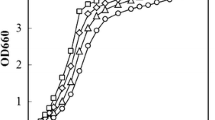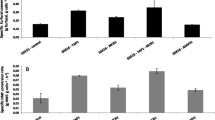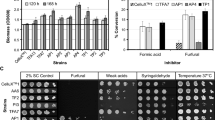Abstract.
Lignocellulose hydrolysates, obtained by acid hydrolysis for production of bioethanol, contain, in addition to fermentable sugars, compounds that inhibit the fermenting micro-organism. One approach to alleviate the inhibition problem is to use genetic engineering to introduce increased tolerance. Phenylacrylic acid decarboxylase (Pad1p) catalyses a decarboxylation step, by which aromatic carboxylic acids are converted to the corresponding vinyl derivatives. Pad1p-overexpressing Saccharomyces cerevisiae was cultivated in synthetic medium in the presence of model compounds, ferulic acid [(2 E)-3-(4-hydroxy-3-methoxyphenyl)prop-2-enoic acid] and cinnamic acid [(2 E)-3-phenylprop-2-enoic acid], as well as in a dilute acid hydrolysate of spruce to examine the resistance against fermentation inhibitors. Overexpression of S. cerevisiae phenylacrylic acid decarboxylase (Pad1p) resulted in an improved growth rate and ethanol productivity in the presence of ferulic acid, cinnamic acid, and in a dilute acid hydrolysate of spruce. Vinyl guaiacol (2-methoxy-4-vinylphenol) was identified as a major metabolite of ferulic acid, and dihydroferulic acid [3-(4-hydroxy-3-methoxyphenyl)propanoic acid] was detected under oxygen-limited conditions. Styrene (vinylbenzene) and dihydrocinnamic acid (3-phenylpropanoic acid) were identified as metabolites of cinnamic acid. Transformants overexpressing Pad1p had the ability to convert ferulic and cinnamic acid at a faster rate than a control transformant (PADC) not overexpressing Pad1p. This enabled faster growth for Pad1p-overexpressing transformants under both aerobic and oxygen-limited conditions. Pad1p activity was also studied using non-growing cells. The overexpressing transformants showed approximately tenfold higher activity than PADC. The Pad1p overexpressing transformants also showed a 22–25% faster glucose consumption rate, a 40–45% faster mannose consumption rate, and a 24–29% faster ethanol production rate in the dilute acid hydrolysate of spruce.
Similar content being viewed by others
Author information
Authors and Affiliations
Additional information
Received revision: 24 May 2001
Electronic Publication
Rights and permissions
About this article
Cite this article
Larsson, .S., Nilvebrant, .NO. & Jönsson, .L. Effect of overexpression of Saccharomyces cerevisiae Pad1p on the resistance to phenylacrylic acids and lignocellulose hydrolysates under aerobic and oxygen-limited conditions. Appl Microbiol Biotechnol 57, 167–174 (2001). https://doi.org/10.1007/s002530100742
Received:
Accepted:
Issue Date:
DOI: https://doi.org/10.1007/s002530100742




